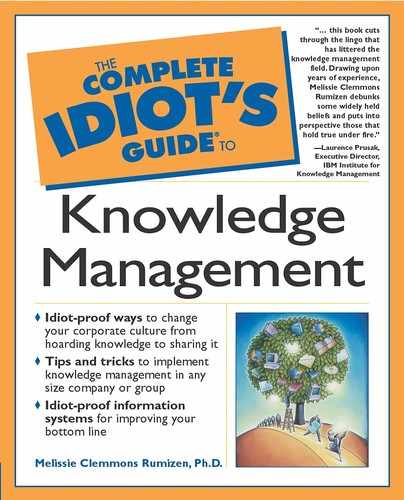
Chapter 9
Strategic Choices for Connecting People to People
In This Chapter
▶ Sharing knowledge through the yellow pages
▶ Encouraging participation in the yellow pages
▶ Avoiding pitfalls
▶ Connecting knowledge and people through best practice systems
In this chapter, we’ll continue to look at some of the approaches used in knowledge management. Some focus on using technology to further connect people to people, such as an electronic corporate yellow pages as well as other technological packages. Another approach—best practice systems—focuses on capturing explicit knowledge and connecting to those with the knowledge.
Look in the Yellow Pages
Up until now you might have thought that the yellow pages were part of your phone book. Or you had seen ads on TV for various providers of yellow pages, urging people to place or use ads. At knowledge management conferences, though, you heard people talk about yellow pages for finding other people in the organization.
There are also vendors with various packages who use technology to help locate expertise in organizations. Although those sound a bit gee whiz, they offer another way to help employees connect and share knowledge and skills. Both the corporate yellow pages (with data entered by people who have listed themselves) and the expertise finders (generated by software) hone in on finding people with distinctive expertise.

Know These
A corporate yellow pages is a mechanism to help people locate others in the organization with expertise they might need. They often utilize individual Web pages. They also are called expertise directories.
Best practices systems, meanwhile, are both a way of connecting people and a way of documenting knowledge. These approaches are driven by the need to find people who know what we need to know. Even if we aren’t in a large, global, decentralized organization, we may have no way of finding out that Mary down the hall has the knowledge we need. While communities of practice can help us find our peers working in the same area of interest, they may be no help beyond the boundaries of our community of practice. Unfortunately, our jobs often go beyond those boundaries.
When British Petroleum merged with Amoco, the new organization had thousands of employees scattered across the globe who didn’t know each other. BP created a corporate yellow pages system to connect employees to knowledge and each other, and called it Connect. As with their virtual-teaming program, BP experimented with a formal coaching program. However, the approach was difficult to scale up, and ultimately local staff carried out any coaching informally.

Didn’t Know
Tony Carrozza, formerly of Hewlett-Packard, poses this challenge: Can you find an expert in scanning electron microscopy who belongs to a particular organization, speaks Italian, and lives in the San Francisco Bay area, all in 60 seconds? Chris Collison poses a different challenge but no less difficult: Find someone who knows about deep-water drilling, speaks fluent Russian, and is currently in southwest London. You may not ever face these challenges, but during the course of work in many different types of organizations, we do confront similar challenges.
BP found that the seniority of the employee impacted what type of information he or she entered into the yellow pages:
▶ Younger employees tended to hone in on competence and qualifications.
▶ Mid-career employees mention their job experience and network affiliations in the organization.
▶ Most senior employees describe key relationships, often external to the organization.
Best practice systems, corporate yellow pages, and other ways of finding expertise help people span boundaries and reach each other. Once found, people can share knowledge, reduce duplication of effort, and identify opportunities for collaboration. As always, connecting people to people so that they can share knowledge reaps important benefits.
Yellow Pages for Expertise
Let’s look in more detail at yellow page systems and how they’re used, starting with how Texaco does it.
Prior to the merger with Chevron, Texaco had a corporate yellow pages system called PeopleNet. It illustrates the types of information usually included on these systems. The main page contains the following features:
▶ Today’s featured people. Two people selected at random appear each day. At British Petroleum, this feature is called “15 minutes of fame.” Every time employees update their details, the home page shows their name and photograph. Their 15 minutes last until the next person to do an update boots them off. Both approaches offer a way to highlight individuals, which also makes the yellow pages more personal.
▶ The ability to browse and do an advanced search for expertise. There is a skill hierarchy that can be expanded as well.
The problem with using technology to find people is that it makes high tech something we like to do low tech (face-to-face). A database doesn’t tell us if we can collaborate with different individuals, if we can trust them, or if we can rely on them. Pictures aren’t a substitute for meeting someone in person, but they do make entries in databases seem more like real people. Also, databases that include other contacts may help someone identify people they know that know that person. That can help to transform the database entry into an approachable person.
Once a person has been located, that person’s own page includes
▶ Basic contact information.
▶ Areas of expertise. People can rate themselves as having extensive expertise, some working knowledge, or just learning. 

Know These
The Myers-Briggs type indicator is a test designed to figure out how you deal with people and situations and make decisions. It deals with how people take in information (sensing versus intuition) and how they make decisions (thinking versus feeling). There are many Web sites devoted to this subject (for example, www.personalitypathways.com).
▶ A work history.
▶ Their Myers-Briggs type indicator.
▶ Key internal and external contacts.
▶ Interests and links.
Optional items are a picture and membership in communities of practice.
Privacy laws vary from country to country. In Europe, for example, privacy laws forbid disclosing this type of information without the employee’s permission. Check with your legal department when designing a yellow pages site or publication to learn what the local laws are. Also, work with your legal beagles to draft a written corporate policy governing the use of yellow pages.
Keys for Success
One key to yellow pages success is making participation voluntary. Many companies, such as Hewlett-Packard and British Petroleum, encourage but don’t require participation. Employees decide on their own if they want to participate.
You may get only one chance to convince people that a corporate yellow pages is worthwhile. Unfortunately, you also need a critical mass of submissions to make the database worthwhile. Critical mass may be smaller than you think, as Hewlett-Packard discovered. But be aware that there must be enough people in the database to make it worthwhile for users to turn to.
Something that requires too much work will turn off users. Most organizations use a simple template for users to enter information about themselves. Aim for no more than 30 minutes to enter the information; in fact, you may want to aim for no more than 10 minutes. Give context-sensitive help for individual fields. Provide some selection lists and check boxes. To build momentum and encourage participation, market the yellow pages. At British Petroleum they used posters, competitions, learning fairs, and lunchtime publicity booths to grow awareness, and thus submissions. You could run promotions, giving out small tokens for entries. You may want to provide opportunities for people to learn more about technology for adding to their entries, such as how to upload pictures or use of graphics. But the bottom line for motivating people to make the effort is that knowledge workers are eager to find expertise they need. If they share what they know, others will as well.
Any yellow pages system treads on the territory of your human resources department. Team up with someone from HR to position your system as a complement to existing systems.

Know How
Another inducement for people to submit their information is the chance to be creative. For individuals, this is in effect their personal Web page. They can advertise what they know—and many knowledge workers are fiercely proud of what they know. They can talk about what interests them. They can have fun with choosing what picture to show. At some companies people have even chosen to represent themselves with famous alter egos. This also can tap into a competitive spirit: “My page is better than your page.” At British Petroleum there were even duels capitalizing on the “15 minutes of fame” feature.
Danger Ahead
Any kind of data must be maintained and kept up-to-date. Yellow pages are no exception. The information that goes most quickly out-of-date is personal contact information: phone numbers, locations, and e-mail addresses. You can fix this problem by linking the yellow pages to human resources databases, so that the yellow pages can be updated automatically.
A system also can be set up to nag automatically. The system is configured to send an e-mail reminder to users who haven’t updated their profiles in a certain period of time. Every 6-12 months is a good time frame for information that is less subject to change. However, nagging runs the risk of antagonizing people, either because the information hasn’t changed or because they just don’t like to be nagged.
Automation
Various expertise-profiling companies offer software packages for locating people. Packages vary, but can
▶ Monitor desktop behavior, like document creation.

Know Nos
As with communities of practice, yellow pages are best handled with a light hand by management. Although it may seem more efficient to develop a validation process for entries involving review by management, it could stop the knowledge worker horse from going to the water at all. Reviewing a profile during a work-review process might be a less heavy-handed method.
▶ Tap into browsing behavior on an intranet.
▶ Track e-mail, including addresses and subject matter.
▶ Track community activity such as message posting and document posting.
▶ Interface to multiple sources like human resource systems, project databases, calendars, and training databases.
One result is a profile of individuals. An advantage of this approach is that the sources of information are much more varied and comprehensive than a Web page. These profiles are also generated unprompted, freeing the user from the requirement to enter and update information. Additional benefits can be identifying patterns of knowledge, finding gaps in organizational knowledge and tracking competencies—all automatically.
By identifying people with common needs and abilities, these systems can also be useful for identifying communities of practice. This is a key feature for any organization wanting to implement communities of practice, the killer application of KM.
The stumbling block is privacy. Do you want your organization’s computer system snooping through your e-mail and publishing your availability for an area of expertise? This question and related ones for this type of system can set off organizational fireworks. Therefore, managers have to know what they’re getting into when they consider such systems.
The solution offered by many vendors to the privacy issue is privacy protections. Individual users decide what they wish to share. For example, if the system determines that you’re the person most likely to be able to answer a question, a request is sent to you that is invisible to the requestor. You then can decide if you want to answer it. If not, you’re free to ignore it.

Know How
One of the biggest barriers to transferring knowledge is that no one knows who knows what. A best practices system helps document what’s known and who knows it. That’s the first step in transferring knowledge.
Best Practice Systems
Remember that a best practice is something that has been shown to be effective in one place that could be effective in another. Organizations waste a lot of time and money reinventing the wheel—or, worse yet, failing at something even though someone somewhere has a method that will work. The purpose of a best practice system, then, is to make it possible to find and use what’s already there.
Best practices systems also add another dimension to finding people by linking people to specific knowledge. The result is targeted: People know what knowledge they want and who can provide the full context for them.
Best Practices Help the American Red Cross
The American Red Cross has a best practices system that illustrates the principles common to many similar systems. The goals of that system are to
▶ Identify and transfer programs and business practices that are innovative and successful.
▶ Foster constructive communication within the organization.
▶ Enable the organization to recognize and acknowledge successful practices and those who submit them.
Finding the system is easy. On the home page of the American Red Cross’s internal Web, CrossNet, the menu has an area titled “Best Practices.” Additionally, the individual lines of service and departments have a button on their own page. The idea is to give people multiple ways to enter the system. This makes it easy to use. The best practices page has
▶ An area for posting feedback. This gives people a chance to comment on the usefulness of the system and also to suggest topics that need best practices.
▶ A link to a highlights page. This page gives a list of the most recent additions to the system and gets updated monthly.
▶ Links to practices currently in the system. For example, the American Red Cross chapter in Richmond, Virginia, has a best practice for working with part-time employees.
▶ A form for submitting best practices. Based on user feedback, this form was revised to make it even simpler.
To submit a practice, people must give information on four key issues:
▶ The objective of the practice
▶ An explanation of how it is done
▶ What showed that the practice worked
▶ Benefits and risks associated with the practice
The person submitting must also indicate the appropriate line of service or department and a name for the process.

Know Nos
Don’t design a best practices system in a vacuum. Design it for the users. Consultant and knowledge management author Verna Allee tells of a large technology company that spent $7 million on a best practices system for technology consultants. None of that money went toward talking to users about how they used and shared information. None of the targeted users actually used the best practices system, either.
To categorize the practices, the American Red Cross developed its own taxonomy. (A taxonomy is a framework for organizing information.) Participants gave a list of topics for their areas. The goal was to come up with a list that fit every situation and line of service. There is an easy drop-down menu for users to click on when they submit the practices.
framework for organizing information.) Participants gave a list of topics for their areas. The goal was to come up with a list that fit every situation and line of service. There is an easy drop-down menu for users to click on when they submit the practices.

Know How
A best practice system must have some way to organize the content in a logical manner so that users can find the practices they’re looking for. Taxonomies are a common way for doing this. Arthur Andersen and the American Productivity and Quality Center One developed a well-known taxonomy for standard business practices. It’s available for free on the APQC website, www.apqc.org.

Know Nos
Don’t allow people to submit best practices anonymously. No one can give enough information in a best practices system. People must be available to answer questions potential users might have. One large company even designed a best practices system to have minimal information on the practice itself. The intent was to force people to talk to each other.

Know Nos
Don’t design a best practices system in a vacuum. Design it for the users. Consultant and knowledge management author Verna Allee tells of a large technology company that spent $7 million on a best practices system for technology consultants. None of that money went toward talking to users about how they used and shared information. None of the targeted users actually used the best practices system, either.
Once submitted, a best practice is subject to review to make sure it does not violate policies and procedures or that it is something that should be a part of other people’s procedures. A person submitting a practice gets written notification of the review results.
In little more than a year, the system grew from a few practices to more than 100 relating to every line of service and nearly every function in an American Red Cross chapter. Feedback from the users is that they want more and more practices. They like seeing what others are doing. They often combine ideas from different practices to get a tailored solution for their situation.
The results for the American Red Cross’s system include
▶ Saving time for the people who use them.
▶ Saving time for the people who submit practices. Since the practice is documented, they don’t spend as much time answering lengthy questions from people who then may not use them. The calls they do get are much more specific and take less time to answer.
▶ Expanding the horizon for local chapters. One chapter printed out all of the practices on a given topic, sat down with their local board, and reviewed them. They saw possibilities they had never seen before.
▶ Giving individuals a chance to grow and succeed. People get exposure for their achievements and good ideas. One person who submitted a practice is now in demand across the U.S. Others are presenting with all expenses paid at an annual American Red Cross conference.
Some key elements to keep in mind for making a best practices system succeed are
▶ Tying it to business drivers. These best practices are aligned with lines of services and departments at the American Red Cross.
▶ The ability to contact the person who has the context for the knowledge and thus also a chance to validate the content.
▶ Monitoring the usage and the goals, as provided by the staff at American Red Cross headquarters.
▶ Recognition for those who submit best practices.
A proven best practice that can be leveraged across your entire organization is a big payoff for a best practices system. Be sure to design any best practices system to look for demonstrated practices that are transferable to many other parts of your organization.
Making People-Finders Part of a Larger System
While both yellow pages and best practice systems can provide value as a stand-alone system, I think they’re best used in conjunction with other approaches. Chevron is a great example of an organization that uses multiple approaches to connect people. Their system includes the following:
▶ A best practices database
▶ A lessons-learned database
▶ Communities of practice
▶ Project documentation and reporting process
▶ Corporate yellow pages
All of these give people multiple ways to find the other people and expertise they need, an important goal for a KM program However, no single approach is enough to meet all of the users’ needs. Additionally, the approaches can be linked. Linking is one of the great enablers technology provides. For example, in PeopleNet, employees can list the communities they belong to, connecting those who access their profile to their affiliated communities. Texaco has also tried combining PeopleNet and an automated package for identifying expertise. While you may want to pilot one approach initially as part of your KM program, consider an eventual architecture that combines ways for locating expertise.
The Least You Need to Know
▶ Corporate yellow pages are a way to find expertise in an organization.
▶ Expertise profiling companies also provide automated means of locating expertise that tap multiple sources.
▶ Best practices systems offer both a way to find people and specific knowledge that they have.
▶ Consider having more than one way of locating people and knowledge.
..................Content has been hidden....................
You can't read the all page of ebook, please click here login for view all page.
